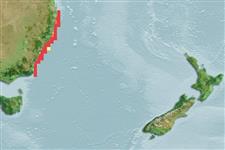Élasmobranches (requins et raies) (sharks and rays) >
Myliobatiformes (Stingrays) >
Urolophidae (Round rays)
Etymology: Urolophus: Greek, oura = tail + Greek, lophos = crest (Ref. 45335).
More on author: Whitley.
Environment: milieu / climate zone / profondeur / distribution range
Écologie
marin démersal; profondeur 45 - 300 m (Ref. 9863), usually 100 - 160 m (Ref. 9863). Temperate; 26°S - 38°S, 149°E - 154°E
Southwest Pacific: Australia, from Queensland to New South Wales. Possibly hybridizes with the largely allopatric banded stingaree Urolophus cruciatus (a more southern species), and perhaps one of the few known cases of chondrichthyan hybridization.
Length at first maturity / Taille / Poids / Âge
Maturité: Lm ?, range 23 - ? cm
Max length : 42.0 cm TL mâle / non sexé; (Ref. 9863)
Little is known of its biology (Ref. 6871).
Life cycle and mating behavior
Maturité | Reproduction | Frai | Œufs | Fécondité | Larves
Last, P.R. and J.D. Stevens, 1994. Sharks and rays of Australia. CSIRO, Australia. 513 p. (Ref. 6871)
Statut dans la liste rouge de l'IUCN (Ref. 130435: Version 2025-1)
Menace pour l'homme
Harmless
Utilisations par l'homme
Outils
Articles particuliers
Télécharger en XML
Sources Internet
Estimates based on models
Preferred temperature (Réf.
123201): 14.1 - 21, mean 18.2 °C (based on 11 cells).
Phylogenetic diversity index (Réf.
82804): PD
50 = 0.5000 [Uniqueness, from 0.5 = low to 2.0 = high].
Bayesian length-weight: a=0.00813 (0.00372 - 0.01775), b=3.08 (2.88 - 3.28), in cm total length, based on LWR estimates for this (Sub)family-body shape (Ref.
93245).
Niveau trophique (Réf.
69278): 3.5 ±0.4 se; based on size and trophs of closest relatives
Résilience (Réf.
120179): Faible, temps minimum de doublement de population : 4,5 à 14 années (Assuming fecundity<100).
Fishing Vulnerability (Ref.
59153): Low to moderate vulnerability (32 of 100).
🛈
